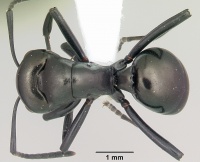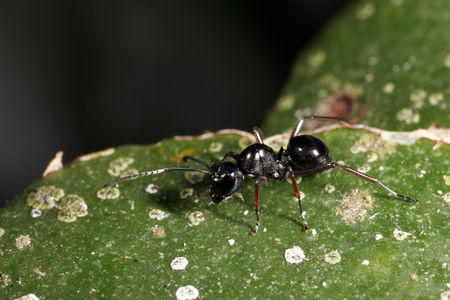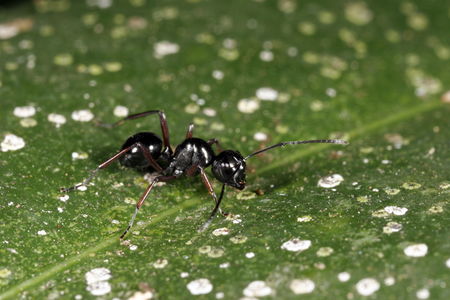Cyrtomyrma
| Cyrtomyrma | |
|---|---|

| |
| Polyrhachis gibba | |
| Scientific classification | |
| Kingdom: | Animalia |
| Phylum: | Arthropoda |
| Class: | Insecta |
| Order: | Hymenoptera |
| Family: | Formicidae |
| Subfamily: | Formicinae |
| Tribe: | Camponotini |
| Genus: | Polyrhachis |
| Subgenus: | Cyrtomyrma Forel, 1915 |
| Type species | |
| Formica rastellata, now Polyrhachis rastellata | |
| Diversity | |
77 species
 Polyrhachis gibba lateral view  Polyrhachis gibba dorsal view | |
Rudy Kouhout (2006) provides this introduction to the subgenus: Cyrtomyrma is one of the relatively well defined subgenera of Polyrhachis. However, it is a taxonomically difficult group with many very similar species that are frequently confused and misidentified.
Photo Gallery
 Nest between leaves. Polyrhachis australis.
Nest between leaves. Polyrhachis australis. Nest entrance. Polyrhachis australis.
Nest entrance. Polyrhachis australis. Nest with one leaf partially removed. Polyrhachis australis.
Nest with one leaf partially removed. Polyrhachis australis.
Identification
Kohout (2006): With a highly convex, dome-shaped and mostly very finely sculptured mesosoma, the majority of Cyrtomyrma species bear a superficial resemblance to some members of the P. mucronata-group of the subgenus Myrmhopla Forel. However, virtually all Cyrtomyrma species have a distinct posterolateral carina separating the gena from the ventral parts of the head, a character lacking in all known species of the P. mucronata-group. The two groups also differ in the configuration of the petiole. In Cyrtomyrma the petiole is scale-like and usually armed with four (or more rarely two) teeth or spines. In contrast, the petiole in P. mucronata-group species is columnar and armed with two, more-or-less horizontal, posteriorly directed spines that usually curve to the shape of the gaster. In addition, the petiole often bears a pair of short, intercalary teeth. The pupae also differ between the two groups, being naked in all known Cyrtomyrma species (a character shared with members of the subgenus Myrmatopa Forel), and enclosed within cocoons in P. mucronata-group species. The species of both groups have similar nesting habits, building nests of silk and vegetation debris upon the leaves of various plants.
| See images of species within this genus |
Keys to Species in this Genus
- Key to Australian Polyrhachis (Cyrtomyrma) species
- Key to Sulawesi Polyrhachis Cyrtomyrma species
- Key to Papuasian Polyrhachis Cyrtomyrma species
- Key to Polyrhachis Cyrtomyrma of China and the Indo-China Peninsula
- Key to Polyrhachis Cyrtomyrma of Borneo
- Key to New Guinea Polyrhachis Cyrtomyrma
- Key to Solomon Island Polyrhachis Cyrtomyrma
Species
Sulawesi
Biology
All known species are arboreal, building nests of silk and vegetation debris between the leaves and shrubs of trees. However, some species are occasionally lignicolous, using available cavities such as bamboo internodes or hollow branches, the walls of which they line with silk (Robson & Kohout, 2005). Some species (e.g. Polyrhachis inducta, Polyrhachis mondoi) have also been found nesting under bark on living trees.
Distribution
The known distribution of the subgenus ranges from China to India and Sri Lanka and south across Indonesia and New Guinea to the Solomon Islands and northern Australia (Kohout 2006).
Nomenclature
The following information is derived from Barry Bolton's Online Catalogue of the Ants of the World.
- CYRTOMYRMA [subgenus of Polyrhachis]
- Cyrtomyrma Forel, 1915b: 107 [as subgenus of Polyrhachis]. Type-species: Formica rastellata, by original designation.
Description
Worker
Kohout (2006): Diagnosis. Relatively small ants (HL < 2.10) with general characteristics of the genus. Head relatively large, more-or-less triangular in frontal view, with sides moderately convex and anteriorly converging in front of eyes; behind eyes, sides of head rounded into broadly convex occipital margin; strong, longitudinal carina running from occipital corners towards mandibular bases and separating gena from ventral parts of head (carina absent in Polyrhachis achterbergi and Polyrhachis widodoi). Mandibular masticatory border with 5 teeth, apical tooth longest, subsequent teeth gradually reducing in length. Anterior clypeal margin in most species with central, truncate flange, usually notched medially and flanked by distinct angles or acute denticles (anterior clypeal margin deeply emarginate medially in P. widodoi; with a central, projecting blunt tooth in P. achterbergi); basal clypeal margin usually only moderately impressed, laterally indicated by a thin line. Eyes relatively large, ranging from flat to distinctly convex; ocelli mostly absent. Frontal carinae strongly sinuate in most species. Mesosoma moderately to strongly longitudinally and transversely convex, with dorsum totally immarginate. Pronotal humeri toothed, angular or simply rounded; promesonotal suture distinct, metanotal groove absent or weakly indicated by a faint line or slight depression in lateral outline. Propodeum armed with short spines, tubercles, or completely unarmed, descending into declivity in a more-or-less smooth, medially uninterrupted line. Petiole scale-like, usually armed with four spines or teeth of variable length and configuration, rarely with backwards directed, long and slender lateral spines (as in Polyrhachis sedlaceki) or with all spines reduced to minute denticles (as in Polyrhachis semiinermis, Polyrhachis danum and Polyrhachis brevinoda). Gaster large, globose, first segment occupying about half its length. All body surfaces rather smooth (highly polished in P. sedlaceki), with sculpturation consisting mostly of very fine, superficial reticulations with scattered minute pits; sculpture becoming distinctly more coarsely reticulate laterally; a few species (P. achterbergi, Polyrhachis bruehli, Polyrhachis inflata, Polyrhachis luctuosa, Polyrhachis vitalisi and P. widodoi) with head, mesosoma and petiole more heavily sculptured, reticulate-punctate, opaque. Colour of body mostly black, more rarely blue.
Queen
Kohout (2006): Diagnosis. Similar to worker, with usual characters identifying full sexuality, including three ocelli and fully developed thoracic structure with wings. Armament of pronotal humeri markedly reduced; propodeal and petiolar spines distinctly shorter, but queens of some species (e.g. Polyrhachis robsoni) with short propodeal spines that are completely absent in workers; sculpturation and colour virtually identical to worker.
References
- Bolton, B. 2003. Synopsis and Classification of Formicidae. Mem. Am. Entomol. Inst. 71: 370pp (page 124, Cyrtomyrma as subgenus of Polyrhachis)
- Dorow, W. H. O. 1995. Revision of the ant genus Polyrhachis Smith, 1857 (Hymenoptera: Formicidae: Formicinae) on subgenus level with keys, checklist of species and bibliography. Cour. Forschungsinst. Senckenb. 185:1-113
- Emery, C. 1925d. Hymenoptera. Fam. Formicidae. Subfam. Formicinae. Genera Insectorum 183: 1-302 (page 207, Cyrtomyrma as subgenus of Polyrhachis)
- Forel, A. 1915b. Results of Dr. E. Mjöbergs Swedish Scientific Expeditions to Australia 1910-13. 2. Ameisen. Ark. Zool. 9(1 16: 1-119 (page 107, Cyrtomyrma as subgenus of Polyrhachis)
- Forel, A. 1917. Cadre synoptique actuel de la faune universelle des fourmis. Bull. Soc. Vaudoise Sci. Nat. 51: 229-253 (page 251, Cyrtomyrma as subgenus of Polyrhachis)
- Klimeš, P., Drescher, J., Buchori, D., Hidayat, P., Nazarreta, R., Potocký, P., Rimandai, M., Scheu, S., Matos-Maraví, P. 2022. Uncovering cryptic diversity in the enigmatic ant genus Overbeckia and insights into the phylogeny of Camponotini (Hymenoptera:Formicidae:Formicinae). Invertebrate Systematics, 36(6), 557-579 (doi:10.1071/is21067).
- Kohout, R. J. 2006. Review of Polyrhachis (Cyrtomyrma) Forel (Hymenoptera: Formicidae: Formicinae) of Australia, Borneo, New Guinea and the Solomon Islands with descriptions of new species. Memoirs of the Queensland Museum. 52:87-146.
- Robson, S. 2020. Spiny Ants (Polyrhachis). Encyclopedia of Social Insects, pp. 1–6. (doi:10.1007@978-3-319-90306-4_115-1).
- Wheeler, W. M. 1922i. Ants of the American Museum Congo expedition. A contribution to the myrmecology of Africa. VII. Keys to the genera and subgenera of ants. Bull. Am. Mus. Nat. Hist. 45: 631-710 (page 701, Cyrtomyrma as subgenus of Polyrhachis)



